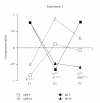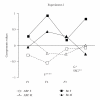Anxiety in mice: a principal component analysis study
- PMID: 17502910
- PMCID: PMC1847470
- DOI: 10.1155/2007/35457
Anxiety in mice: a principal component analysis study
Abstract
Two principal component analyses of anxiety were undertaken investigating two strains of mice (ABP/Le and C57BL/6ByJ) in two different experiments, both classical tests for assessing anxiety in rodents. The elevated plus-maze and staircase were used for the first experiment, and a free exploratory paradigm and light-dark discrimination were used for the second. The components in the analyses produced definitions of four fundamental behavior patterns: novelty-induced anxiety, general activity, exploratory behavior, and decision making. We also noted that the anxious phenotype was determined by both strain and experimental procedure. The relationship between behavior patterns and the use of specific tests plus links with the genetic background are discussed.
Figures


References
-
- Crawley JN, Goodwin FK. Preliminary report of a simple animal behavior model for the anxiolytic effects of benzodiazepines. Pharmacology Biochemistry and Behavior. 1980;13(2):167–170. - PubMed
-
- Rodgers RJ, Cao BJ, Dalvi A, Holmes A. Animal models of anxiety: an ethological perspective. Brazilian Journal of Medical and Biological Research. 1997;30(3):289–304. - PubMed
-
- Sánchez C. 5-HT1A receptors play an important role in modulation of behavior of rats in a two-compartment black and white box. Behavioural Pharmacology. 1996;7(8):788–797. - PubMed
-
- Griebel G, Belzung C, Misslin R, Vogel E. The free-exploratory paradigm: an effective method for measuring neophobic behaviour in mice and testing potential neophobia-reducing drugs. Behavioural Pharmacology. 1993;4(6):637–644. - PubMed
-
- Shimada T, Matsumoto K, Osanai M, Matsuda H, Terasawa K, Watanabe H. The modified light/dark transition test in mice: evaluation of classic and putative anxiolytic and anxiogenic drugs. General Pharmacology. 1995;26(1):205–210. - PubMed
Publication types
MeSH terms
LinkOut - more resources
Full Text Sources
Medical

